Behind the airstrikes: Israel’s strategic push to fragment Syria

TEHRAN - Recent weeks have seen Israel intensify its military operations in both Gaza and Syria. The entire international community has been in complete panic since then.
Tel Aviv officials portray the attacks as measures of protection for Israel and minorities, while a closer look shows a vicious hand is at work.
There are growing concerns over Israel's deepening involvement in Syria, where its military actions are increasingly seen not merely as deterrent measures but as instruments in a broader strategy to reshape the regional strategic landscape.
A deadly situation in Syria
Following the collapse of the ceasefire between Syrian forces and Druze militias in Suwayda, southern Syria has become the fresh front of Israel. Sectional clashes saw over 100 Druze civilians murdered, which was cited as a justification for Israeli interventions.
While Israel claims that it seeks to protect the Druze, with reference to ties to the Golan Heights community, analysts contest it, instead pointing to increased civilian casualties and displacement produced in Suwayda and Daraa by Israeli airstrikes.
Nonetheless, with little casualty reporting from either Israeli or Syrian fronts, exact figures remain unclear, but humanitarian agencies do stand to confirm that dozens of people were killed and injured over the past few weeks. They also complain that rather than securing and stabilizing the region, Israel is further sharpening sectarian tensions.
Eradicating Syria’s military infrastructure
The broader objective behind Israel’s operations in Syria appears increasingly focused on eliminating what remains of Syria’s military capacity. Since the collapse of Bashar al-Assad’s government in late 2024, Israel has launched over 350 airstrikes on Syrian territory. These attacks have targeted key military assets, including missile storage facilities, air defense systems, and naval infrastructure.
According to regional security experts and multiple independent sources, between 70% and 90% of Syria’s former military infrastructure has now been destroyed. This goes far beyond deterring potential threats; it represents a preemptive dismantling of Syria's ability to reemerge as a strategic actor. Some observers characterize this as a form of warfare aimed not merely at the country’s targets but at ensuring the permanent fragmentation and disempowerment of the Syrian state.
Strategic interests disguised as humanitarian concerns
Israel’s emphasis on protecting Druze communities in southern Syria has been met with widespread skepticism. The shared ethnic bonds between Israeli Druze and Syrian Druze may hold certain cultural truth, but it is the geopolitical expediency of this narrative that analysts find more compelling.
Hassan Hanizadeh, an expert on Arab affairs, contends that Israel is exploiting local sectarian grievances—particularly the recent massacre of over 100 Druze civilians—as a pretext for deepening military operations and advancing its strategic foothold in southern Syria. He asserts that this campaign is partially aimed at pressuring the de facto leadership of Syria under Ahmad Shar’a (Abu Mohammad al-Julani) and encouraging separatist movements among ethnic and sectarian minorities.
Hanizadeh identifies the Druze, Kurds, Turkmen, and Alawites as communities being pulled into a growing project of fragmentation—one that benefits Israeli and American interests by ensuring Syria never returns to its status as a unified, sovereign actor.
A regional plan for fragmentation and control
The analyst further argues that Israel and the United States are jointly pursuing a regional strategy designed to partition Syria into smaller, ethnically and sectarian-based states. This redrawing of borders and destruction of centralized power structures has significant implications—not only for Syria’s territorial integrity but for the broader stability of the Levant.
In support of this larger vision, the U.S. is reportedly facilitating the mobilization of 15,000 militants near Lebanon, aimed at provoking Hezbollah and increasing cross-border tensions. Meanwhile, Hanizadeh suggests that Julani may be engaged in confidential negotiations with Israel under frameworks established by the Abraham Accords. In return for financial support and political recognition, Julani may agree to abandon Syria’s historic claim to the Israeli-occupied Golan Heights, effectively isolating Hezbollah and weakening Iran’s influence in the region.
He also notes how the erosion of Syria’s traditional military structure—previously loyal to the Assad government—serves to empower Takfiri militias under Julani’s control, further shifting the internal power dynamics in ways that suit Israeli strategic interests.
Humanitarian disasters amid strategic war games
Both Gaza and Syria are enduring severe humanitarian crises worsened by ongoing military actions and political manipulation. Israeli airstrikes in Syria, especially around Suwayda, have caused mass displacement and cut off thousands from vital aid.
Targeting of displacement centers, hospitals, and key roads has crippled humanitarian efforts, with warnings from international organizations about looming famine and disease if attacks continue. Despite the escalating crisis, many Western governments remain largely silent, effectively enabling Israel’s aggressive military strategy.
Critics argue that Israel’s use of air power and proxy militias to control southern Syria deepens instability and fosters radicalization—the very outcomes Israel seeks to avoid. Israel’s operations go beyond immediate security concerns, aiming instead to reshape Syria’s internal dynamics and regional alignment through force and alliances with sectarian groups. The burden falls hardest on civilians in Druze-majority areas caught amid Assad’s government collapse, Takfiri militias’ rise, and persistent foreign intervention.
Leave a Comment